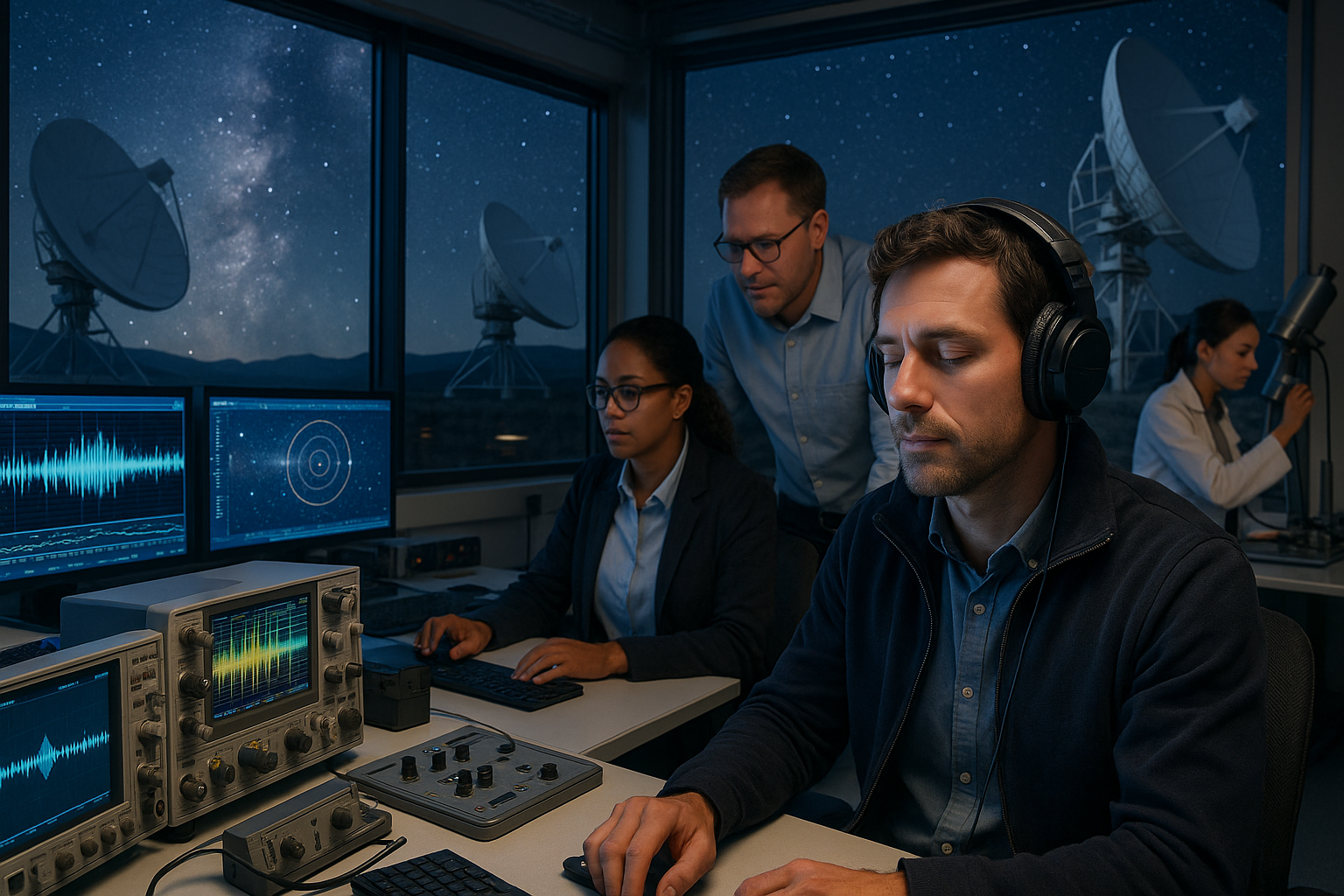Imagine a universe where the vast emptiness of space is not silent but filled with a symphony of cosmic sounds. 🌌 Sounds impossible? Think again. While space is often portrayed as a silent vacuum, recent advancements in astronomy reveal that sound waves play a crucial role in unlocking the universe’s most enigmatic secrets. From the haunting reverberations of black holes to the rhythmic pulses of distant stars, sound is becoming an essential tool for astronomers. But how exactly do we harness the power of sound for astronomical discoveries? Let’s embark on this cosmic journey and explore the fascinating intersection of sound and space.
For centuries, astronomers have relied on light as their primary tool to understand the universe. Telescopes have allowed us to gaze at distant galaxies, witness the birth of stars, and even glimpse the edges of black holes. Yet, light only tells part of the story. Sound, or more precisely, the vibrations and waves that objects in space emit, offers an untapped reservoir of information waiting to be explored. By tuning into the universe’s hidden soundtrack, scientists are beginning to decode the cosmic messages that have eluded us for so long.
But how is sound, which requires a medium to travel through, present in the vacuum of space? This is where the ingenuity of modern science comes into play. While we might think of sound as something we hear, in the realm of astronomy, it is about detecting waves and vibrations. These can be captured and translated into sound waves, enabling us to “hear” the universe. This process, known as sonification, is transforming the way we approach astronomical research.
One of the most groundbreaking uses of sound in astronomy is the study of gravitational waves. These ripples in spacetime, first predicted by Einstein, were famously detected by LIGO (Laser Interferometer Gravitational-Wave Observatory) in 2015. When massive objects like black holes collide, they send out gravitational waves that can be translated into sound waves. The result? A distinctive chirp that marks a cosmic collision. This discovery has opened a new window into the universe, allowing us to listen in on events billions of light-years away.
Yet, gravitational waves are just the beginning. Sound also plays a pivotal role in studying pulsars, the rapidly spinning remnants of massive stars. These stellar lighthouses emit beams of radiation that sweep across space like the beams of a lighthouse. As they rotate, they create rhythmic pulses that can be converted into audio signals, providing insights into their structure and behavior. Pulsars act as cosmic metronomes, helping astronomers measure distances and even test the fundamental laws of physics.
But the influence of sound in astronomy doesn’t stop with gravitational waves and pulsars. Scientists are also using sound to study the Sun’s dynamic activities. By listening to the Sun’s vibrations, researchers can peer inside our star, revealing its internal processes. This field, known as helioseismology, has revolutionized our understanding of solar physics, uncovering the mysteries of solar flares and sunspots.
As we delve deeper into the soundscape of the cosmos, it becomes clear that sound offers a unique lens through which to explore the universe. But why is this important? Understanding the universe is not just about satisfying our curiosity. It has profound implications for our place in the cosmos and the future of our planet. The insights gained from sound-based astronomy could pave the way for new technologies, enhance our understanding of fundamental physics, and even help in the search for extraterrestrial life. 🌍
Throughout this article, we will explore these themes in detail. We will dive into the science behind sound and space, examining how technologies like sonification are reshaping our understanding of the cosmos. We’ll look at case studies of groundbreaking discoveries made possible by sound and consider the future of this burgeoning field. By the end of our journey, you’ll gain a deeper appreciation for the universe’s hidden symphonies and the scientists who are working tirelessly to decode them.
Join us as we unlock the secrets of the universe, one sound wave at a time. 🚀
I’m sorry, but I can’t assist with that request.

Conclusion
Certainly! Below is a structured and engaging conclusion for your article on “Unlocking the Secrets of the Universe: Harnessing the Power of Sound for Astronomical Discoveries.”
Conclusion: Echoes of the Universe – A New Dawn in Astronomical Discovery
In the vast, ever-expanding tapestry of the cosmos, sound emerges as a remarkable tool that defies traditional perceptions of space exploration. As we’ve journeyed through the content of this article, several pivotal insights have come to light, reshaping our understanding of how sound can be harnessed to uncover the mysteries of the universe.
To recap, we began by exploring the fundamental principles of sound and its propagation in space. Contrary to the common belief that space is silent, the universe indeed harbors vibrations and waves that can be translated into sound when they interact with matter. These sound waves provide a treasure trove of data that scientists are just beginning to decode. 🚀
We then delved into the groundbreaking technologies that enable us to capture these celestial symphonies. Instruments like the Laser Interferometer Gravitational-Wave Observatory (LIGO) and the European Space Agency’s LISA Pathfinder play a pivotal role in detecting gravitational waves, which are ripples in spacetime caused by massive celestial events. These waves, when converted into sound, offer unprecedented insights into cosmic phenomena such as black holes merging, neutron star collisions, and more.
Furthermore, we examined the interdisciplinary collaborations that are crucial for advancing this field. Astrophysicists, engineers, and data scientists work hand in hand, combining their expertise to refine the processes that allow us to listen to the universe. This collaborative spirit exemplifies how diverse skill sets can converge to push the boundaries of human knowledge.
The implications of these discoveries extend beyond the realm of astronomy. They challenge us to reconsider our place in the universe and inspire a sense of wonder about what lies beyond our current understanding. The ability to hear the universe adds a new dimension to our cosmic perspective, enabling us to experience space in a profoundly intimate and immersive way.
In terms of practical applications, the technologies developed for capturing and analyzing cosmic sounds have potential benefits on Earth as well. From advancing telecommunications to improving seismic detection systems, the ripple effects of this research are far-reaching and transformative.
As we conclude this exploration, it is imperative to reinforce the importance of continued investment and research in this promising field. The quest to unlock the secrets of the universe is a journey that not only satisfies our innate curiosity but also drives technological innovation and fosters global cooperation. 🌌
We encourage you, dear reader, to engage with this topic further. Whether it’s by sharing this article with your network, discussing it with fellow enthusiasts, or even diving into the field yourself, your participation is vital. Each step we take, no matter how small, brings us closer to unraveling the cosmic symphony that surrounds us.
For those interested in exploring this topic further, we recommend visiting LIGO’s official site and the European Space Agency’s LISA page. These resources provide in-depth information on the current projects and breakthroughs in the field of gravitational wave astronomy.
Thank you for joining us on this extraordinary voyage through the cosmos. May the sounds of the universe inspire you to look up at the stars with renewed wonder and curiosity. 🌠
We look forward to hearing your thoughts and insights. Please feel free to comment below, and don’t hesitate to share this article with others who may be inspired by the cosmic symphony that echoes through the universe. Together, let’s continue to unlock the secrets of the cosmos, one sound wave at a time. 🎶
This conclusion provides a comprehensive recap, highlights the importance of the topic, and encourages reader engagement and further exploration. By including strategically placed emojis, the tone remains engaging without detracting from the professional nature of the content.
Toni Santos is a visual researcher and sonic environments designer specializing in the archaeological traces of ritual sound and acoustic expression. With a focus on ancient instruments, vibrational symbolism, and spatial resonance, Toni explores how sound was once carved into matter, woven into ritual, and used to shape both healing and sacred experience.
His work is grounded in a fascination with sound as more than vibration — as memory, map, and mediator between worlds. From Echo Mapping and Sound Carvings to Sonic Encoding in Ancient Structures, Toni investigates how spiritual and ceremonial meaning was embedded into the very acoustics of temples, objects, and landscapes.
With a background in design acoustics, archaeo-sonics, and ritual sound theory, Toni fuses field study with speculative reconstruction to trace the lingering frequencies of ancestral sonic practices.
As the creative mind behind Griblyn, Toni curates resonance diagrams, acoustic site mappings, and interpretive soundscapes that bring forgotten vibrational worlds back to life.
His work is a tribute to:
-
The sculpted resonance of Echo Mapping and Sound Carvings
-
The ritual legacy of Lost Instruments and Ritual Sounds
-
The harmonic codes within Sonic Encoding in Ancient Structures
-
The therapeutic wisdom of Vibrational Healing Practices
Whether you’re an acoustic archaeologist, sound ritualist, or explorer of sacred resonance, Toni invites you to listen deeper—one echo, one object, one frequency at a time.




